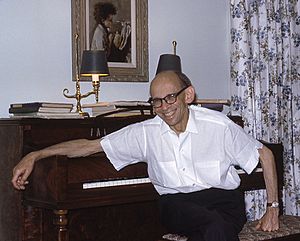Walter Bricht facts for kids
Walter Bricht (born September 21, 1904 – died March 20, 1970) was a talented Austrian-American pianist, composer, and teacher. He created many musical pieces and taught music to many students throughout his life.
Early Life and Music Beginnings
Walter Bricht was born in Vienna, Austria. He grew up in a very musical family. His father, Balduin Bricht, wrote about music for a newspaper. His mother, Agnes Pylleman Bricht, was a concert singer and pianist. She was Walter's first music teacher.
Walter's musical talent was clear from a young age. He started piano lessons when he was only four years old. By the time he was twelve, he was already writing his own piano pieces and songs. He studied at the Vienna Academy for Music. He graduated in 1928 with degrees in composing, conducting, and piano. He was a student of the famous composer Franz Schmidt.
Life and Career in Music
After finishing his studies, Walter Bricht taught music in Vienna. He worked at the Vienna Volkskonservatorium from 1931 to 1938. He also taught singing, piano, and composing at the Horak-Schulen. During this time, he wrote most of his musical works. Many of his pieces were performed publicly, which means people could hear them in concerts.
In 1938, Walter Bricht had to leave Austria. The Nazi government had taken power. They found out that some of his grandparents were Jewish. He was offered a special status by Adolf Hitler if he joined the Nazi party. However, Walter chose to leave Austria and move to the United States of America instead. All his important papers were taken at the border. He arrived in the U.S. without knowing any English.
When he arrived in the U.S., Walter Bricht settled in New York City. He earned money by playing the organ in churches and helping musicians. In 1939, he started teaching at the Mason College of Music in Charleston, West Virginia. The next year, he became the head of the music department. There, he met Donna Kuhn, who became his wife. She was a violin professor he hired.
Walter Bricht moved back to New York in 1944. He continued teaching and coaching until 1963. He also traveled regularly to Washington D.C. to teach members of the U.S. Army Chorus. He and Donna had two daughters, Dana Eve (born 1955) and Wendy Diane (born 1959).
In 1963, Walter Bricht was invited to be a professor at the Indiana University School of Music. He started as a piano professor. By 1967, he was mainly teaching singing and song literature. He wrote three more compositions while at Indiana University: a Sonata for Flute and Piano (1964), a Chaconne for String Quartet (1967), and a Trio for Flute, Cello and Piano (1968). In 1967, a whole concert was dedicated to his music at the university, and it was very well received.
In the mid-1960s, Walter Bricht became ill with emphysema. He passed away in 1970 at the age of 65. His daughters, Dana Bricht Higbee and Wendy Bricht, survived him.
Walter Bricht's Compositions
Walter Bricht's music sounds like the German Late Romantic Style. This means it has rich melodies and harmonies, often expressing strong emotions. He wrote many different kinds of pieces. These included works for choirs, songs for singers, sonatas (pieces for one or two instruments), chamber music (for small groups of instruments), and symphonic works (for large orchestras).
Many of his compositions have an "opus number." An opus number is like a catalog number that composers use to organize their works, usually in the order they were created. For example, "Op. 1" means his first published or major work.
Some of his notable works include:
- Suite in G Dur für Klavier (Op. 1)
- Klaviersonate I in G Moll (Op. 3)
- Klavierkonzert I in F Dur (Op. 4)
- Streichquartett I in H Moll (Op. 14)
- Symphonie in A Moll für grosses Orchester (Op. 33)
- Sonata for Flute and Piano (WoO 23)
- Chaconne for String Quartet (WoO 24)
- Trio for Flute, Violoncello, and Piano (WoO 25)




